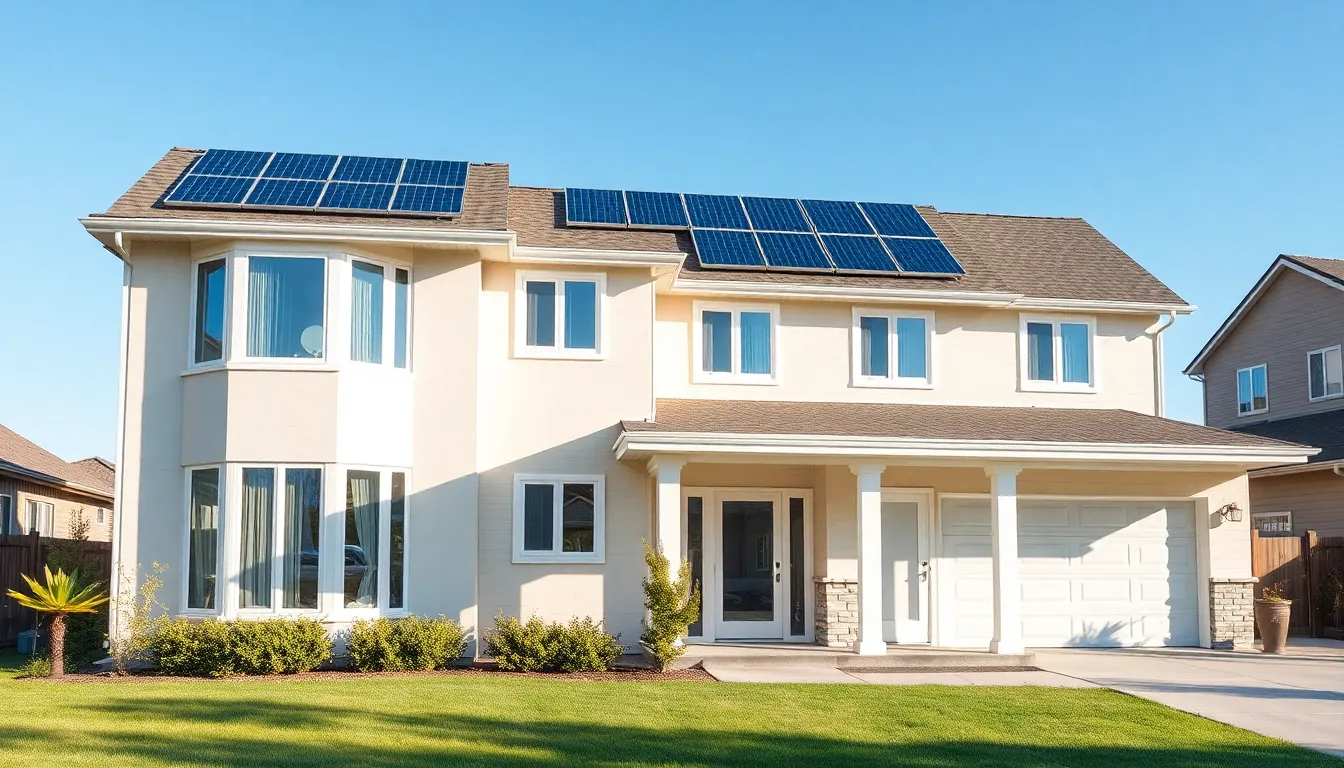Table of Contents
ToggleIn today’s world, energy efficiency isn’t just a trend; it’s a necessity. More homeowners are realizing the importance of reducing energy consumption not only for their wallets but also for the planet. An energy-efficient home minimizes waste and maximizes comfort, making it a smart choice for anyone looking to create a sustainable living environment.
From advanced insulation techniques to smart technology, there are countless ways to enhance a home’s energy efficiency. By adopting these practices, homeowners can significantly lower utility bills while increasing property value. Embracing energy-efficient solutions is not only beneficial for individual households but also contributes to a greener future for everyone.
Understanding Energy-Efficient Homes
Energy-efficient homes utilize design, construction, and technology to minimize energy consumption. These homes not only lower energy costs but also contribute to environmental sustainability.
Definition and Importance
Energy-efficient homes incorporate features and systems that reduce energy usage while maintaining comfort. These homes frequently include high-quality insulation, energy-saving appliances, and efficient heating and cooling systems. The importance of energy efficiency lies in its capacity to decrease greenhouse gas emissions, lower dependency on fossil fuels, and promote sustainable living practices.
Key Benefits of Energy Efficiency
- Cost Savings: Reduced energy consumption leads to lower utility bills, providing significant savings over time.
- Increased Property Value: Energy-efficient features can enhance the market value of a home, appealing to environmentally conscious buyers.
- Environmental Impact: Decreased energy use lowers carbon footprints, contributing positively to the environment.
- Enhanced Comfort: Improved insulation and efficient climate control systems maintain consistent indoor temperatures, enhancing comfort levels.
- Energy Security: Reducing reliance on nonrenewable energy sources promotes energy independence and resilience against price fluctuations.
Components of an Energy-Efficient Home

Energy-efficient homes incorporate specific components that work together to optimize energy use and enhance overall comfort. These components include insulation, windows and doors, and heating, cooling, and ventilation systems.
Insulation and Air Sealing
Insulation and air sealing are crucial for reducing heat transfer between the interior and exterior of a home. Properly installed insulation, such as fiberglass, foam, or cellulose, minimizes energy loss in walls, attics, and crawl spaces. Air sealing focuses on eliminating drafts from gaps and cracks around windows, doors, and other areas. Insulation materials typically have an R-value, which measures thermal resistance; higher R-values indicate better insulating performance. Comprehensive insulation strategies can lead to energy savings of up to 20% on heating and cooling costs.
Energy-Efficient Windows and Doors
Energy-efficient windows and doors significantly reduce energy consumption by minimizing heat gain during summer and heat loss in winter. Double or triple-pane glass options with low-emissivity (Low-E) coatings enhance insulation performance. Frame materials, such as vinyl or fiberglass, also contribute to energy efficiency by providing better insulation than traditional materials. Proper installation ensures airtight seals, further preventing energy loss. Upgrading to energy-efficient windows and doors can lead to a reduction in energy bills by 10-25%.
Efficient Heating, Cooling, and Ventilation Systems
Efficient heating, cooling, and ventilation systems play a vital role in regulating a home’s climate. Modern heating and cooling systems, like high-efficiency furnaces and air conditioners, utilize advanced technology to reduce energy consumption while maintaining comfort. Programmable thermostats and smart home systems increase efficiency by optimizing temperature settings based on occupancy patterns. Ventilation systems, including heat recovery ventilators (HRVs) and energy recovery ventilators (ERVs), improve indoor air quality while recovering energy from exhaust air. Together, these systems contribute to significant energy savings, often ranging from 10% to 30%.
Sustainable Practices for Energy-Efficient Homes
Sustainable practices play a vital role in enhancing energy efficiency in homes. Homeowners can significantly reduce energy consumption by employing renewable energy sources and integrating smart home technology.
Renewable Energy Sources
Renewable energy sources provide clean alternatives to traditional power methods. Solar panels, for instance, harness sunlight to generate electricity, which can decrease overall energy bills and reliance on fossil fuels. Wind turbines, though more suited for rural areas, can also contribute to residential energy needs. Geothermal systems utilize the earth’s consistent temperature to provide heating and cooling. These options can reduce greenhouse gas emissions and often qualify homeowners for tax credits or incentives, further promoting sustainability.
Smart Home Technology
Smart home technology improves energy management and efficiency. Programmable thermostats allow for tailored heating and cooling schedules, optimizing energy use based on occupancy patterns. Smart lighting systems adjust brightness based on natural light availability, reducing electricity consumption. Energy monitors track usage and alert homeowners of high consumption, encouraging behavioral changes. Integrating smart technology into daily life not only enhances comfort but also lowers utility costs, making homes more sustainable.
Tips for Creating an Energy-Efficient Home
Energy-efficient homes utilize specific strategies to minimize energy usage. Implementing effective practices can lead to significant energy savings.
Assessing Energy Consumption
Evaluating energy consumption starts with an energy audit. Homeowners can perform a DIY assessment or hire professionals to identify areas for improvement. Key components of an energy audit include:
- Insulation evaluation: Checking insulation in attics, basements, and crawl spaces can reveal gaps that need sealing.
- Appliance usage: Analyzing the energy ratings of existing appliances helps determine efficiency and identify replacements.
- Lighting analysis: Reviewing lighting fixtures and bulb types ensures the use of energy-efficient lighting options, such as LED bulbs.
- Heating and cooling performance: Inspecting HVAC systems for efficiency ratings and maintenance needs helps optimize performance.
Conducting a thorough assessment can reveal potential energy savings opportunities, often identified through specific metrics.
Making Upgrades and Improvements
Implementing upgrades enhances energy efficiency. Several upgrades yield significant benefits:
- Insulation enhancement: Adding high-quality insulation in walls and attics can reduce heating and cooling costs by up to 20%.
- Window replacement: Installing energy-efficient windows with double or triple-pane glass can lower energy bills by 10-25%.
- Appliance replacement: Upgrading to ENERGY STAR-rated appliances can reduce energy consumption dramatically, often by 10-50%.
- Smart thermostat installation: Incorporating smart thermostats helps manage heating and cooling schedules, leading to energy savings of 10-30%.
Focusing on specific upgrades ensures strategic improvements in energy efficiency, contributing to long-term savings and sustainability.
Embracing energy efficiency in the home is more than just a trend; it’s a vital step toward a sustainable future. Homeowners who invest in energy-efficient upgrades not only enjoy reduced utility bills but also contribute positively to the environment. By focusing on key components like insulation, energy-efficient windows, and modern heating and cooling systems, significant savings can be realized.
Incorporating renewable energy sources and smart technology further enhances these benefits, promoting a comfortable living space while reducing carbon footprints. With practical steps like energy audits and targeted upgrades, anyone can create a more efficient home. The journey toward energy efficiency is both rewarding and impactful, paving the way for a greener tomorrow.







